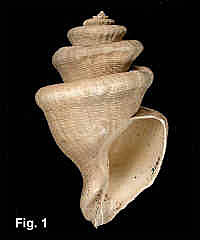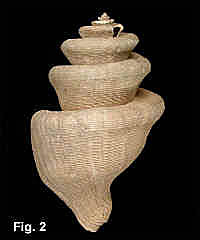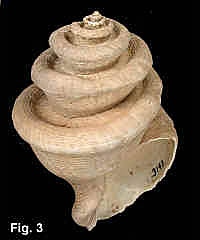|
|
BUCCINIDAE |
|
||||||||

|
Kapala kengrahami Ponder, 1982 Description: Shell light in weight to moderately heavy, round shouldered, suture below the shoulder, with the area between suture and shoulder occasionally flat but usually deeply channelled. Whole surface sculptured with fine spiral lirae and close, inconspicuous axial striae, with weak to moderate nodules or axial folds on the first 3-4 whorls. Outer lip thin, simple. Live shells have a thin, yellowish periostracum. Operculum oval, corneous. Size: Up to 93 mm in length. Distribution: Endemic to Australia; known from Port Stephens, NSW, to Great Australian Bight, in 400-1300 meters. Rare. Remarks: The discovery of this species in 1981 was a noteworthy event in Australian malacology; it is unusual for such a large and distinctive shell, completely new to science, to be found in modern times. But even more remarkable is the series of coincidences surrounding its discovery. The first specimens seen at the Australian Museum, in 1981, were dead shells trawled off the NSW coast. Scientific description of the species was held over in the hope of obtaining live specimens. The shells were shown to a visiting Danish researcher, who later located six live taken specimens in his museum in Copenhagen. These had been taken in the Great Australian Bight by the Galathea Expedition of 1950-53, and stored for 30 years, unrecognised as a significant new species! The next specimen seen at the museum had a more macabre history. A deckhand on the fisheries vessel Courageous showed a shell to Mr. Lance Moore, proprietor of the "Marine Specimens" shell shop in Sydney's Rocks area. Recognising it as a new species, Mr. Moore sent his visitor onto the Australian Museum, where his shell was left for examination, but reclaimed a few days later. Unfortunately, the owner of the shell committed suicide by jumping from the Sydney Harbour Bridge, an event, which, entirely coincidentally, was witnessed by Mr. Moore as he walked in the park under the bridge approaches. The fate of the specimen was never discovered. Figs. 1,2,3: Off Sydney in 280-370 fathoms (DLB3193)
|
|||||||||
|
Copyright Des Beechey 2000 |
||||||||||

